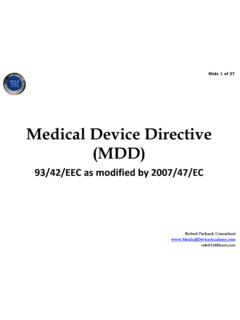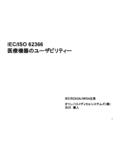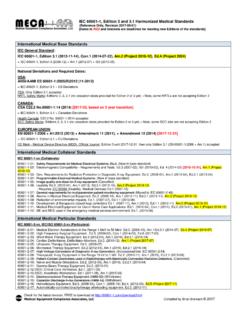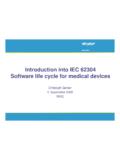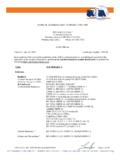Transcription of How to Simplify Compliance with the New ISO …
1 How to Simplify Compliancewith the New ISO 13485:2016 Presented by:Jon D. SpeerFounder & VP QA/RAToday s AgendaISO 13485 OverviewWhat has changed in the new ISO 13485:2016 Why putting off Compliance until later could cost youHow eQMS software can help Simplify compliance5 Steps to take now to make for a smooth transitionQuestionsWho is Jon Speer 18+ years in the medicaldevice industry 40+ products to market Speaker Thought leader and regular contributor at Med Device Online, MedCity News, QMed, Quality Digest and other leading industry publications Expert in implementing quality systems Run one of the most popular blogs & the #1 podcast in the medical device industry Founder and VP QA/RA @ 317 960 Quality Management Software The onlyeQMS solution designed exclusively for the unique needs of the medical device industry Designed by medical device professionals with decades of experience for medical device professionals Offer software + services to enable you to comply with regulations and standards like FDA 21 CFR Part 820
2 And ISO 13485:2016 Customers & partners all over the globe on five continents has been instrumental for us moving so quickly through the ISO certification and I would highly recommend it. My Free Gift For You At The End QMS Audit ChecklistMy Goals For You understand the major changes that are part of this revision of ISO understand the benefit of not putting off Compliance until the last understand how leveraging market leading technology can help Simplify your have an actionable set of steps you can begin taking today at your company to comply with the updated 13485:2016A brief overview?
3 What is ISO 13485? The world- wide sector Quality Management System (QMS) standard for medical device organizations Takes general quality system requirements for all organizations intending to provide products or services to customers and modifies it for application within the highly regulated medical device industry An internationally agreed way to implement common regulatory concepts (presumption of conformity) that support maximizing the potential benefits of making the strategic decision to implement a quality management system?Potential Benefits of ISO 13485 Enhances the ability of the organization to meet customer and regulatory requirements.
4 Helps the organization s capability to address product safety and effectiveness. Allows the organization to obtain external recognition of conformity of the quality management system to accepted requirements (certification).+What ISO 13485 is NOT It is not a required structure for your Quality Management System. It is not regulation not the law. It does not define requirements for the products and services provided by the organization. It does not define other business requirements or initiatives ( financial or environmental requirements).Why did ISO 13485 need to change?
5 The standard was due for revision based on the regular 5- year cycle (second edition released in 2003) First review (2008) determined no change needed. This review (2012/13) there were a couple of drivers. Requests from GHTF and AHWP User survey generally pointed out the need for clarifications (implicit requirements) European Union lost faith in ISO 13485 as a way to obtain presumption of conformity with the EU Medical Device Directive (issuance of EN ISO 13485:2012)User Input Clarity Enhance Clarity for Users Manufacturer s voice Survey of users found a desire for the standard to provide more clarity (implicit requirement) Guidance exists in ISO TR 14969 but few individuals know this document exists (auditor interpretation) Auditing (ambiguity)
6 Certification body s voice Some clauses difficult to audit against Nonconformities could be written against different clauses MDSAP Medical Device Single Audit ProgramUser Input Global Harmonization Further Harmonization Global voice GHTF Study Group 3 had published several guidance documents with additional concepts- - can these be incorporated and used with changes to the standard? More countries developing medical device regulations did not believe ISO 13485 could meet their needs Prevalence of importers & distributors in a few geographies Outsourcing of both manufacturing (contract manufacturing) and design (contract design)
7 Organizations that only do part of the overall process Enhance compatibility with latest regulations and expectationsUser Input EU Challenges Standard not Robust Enough EU Regulator Voice Due to scandals in EU with breast and hip implants the entire regulatory framework was being challenged Determined that ISO 13485 alone and as written could NOT assure presumption of conformity to the MDD s appropriate quality system requirement More prescriptive requirements need to be included in the standardCurrent ISO Timeline ISO 13485:2016 is published. WG1 has started work on a guidance handbook (approx.)
8 1 year) The recommended 3 year transition accepted by TC 210 and IAF no new certifications/re- certifications after year 2 Periodic review has been accelerated to March 2019 What has changed in the new ISO 13485:2016 Overview Integrates risk throughout the QMS and product life- cycle risk- based decision- making Move toward harmonization with US CFR, Brazilian law (ANVISA), CMDR (Canada), and other law (MDD, JPAL, TGA) MDSAP Additional linkage to documentation required for regulatory purposes Integration of QMS softwareOverview (cont.) Emphasis on appropriate infrastructure New references to other standards (usability, sterile barrier, etc.
9 New sections on complaint handling and reporting to regulatory authorities Clarity for auditing Planning and documenting corrective action (without undue delay) and preventive actionAnnexes & Bibliography Annex A comparison between 2003 & 2016 versions Annex B correspondence of sections between ISO 9001:2015 and ISO 13485:2016 Bibliography the information provided helps locate documents referenced in the definitions and in the informational notesList of Clauses Impacted 1 Scope 3 Terms and definitions 4 Quality management system General requirements Documentation requirements Management review Human resources Infrastructure Work environment and contamination control Planning of product realization Customer- related processes Design and development planning Design and development inputs Design and development review Design and development
10 Verification Design and development validation Design and development transfer Control of design and development changes Design and development files Purchasing process Purchasing information Verification of purchased product Control of production and service provision Cleanliness of product Servicing activities Validation of processes for production and service provision Particular requirements for validation of processes for sterilization and sterile barrier systems Identification Preservation of product Feedback Complaint handling Reporting to regulatory authorities Monitoring and measurement of product Control of nonconforming product Analysis of data Corrective action Preventive action1 Scope Scope includes organizations that have a role in one or more stages of the life- cycle Identification of outsourced processes Maintain exclusion for design control if permitted by regulatory requirements with new option to not apply requirements of clauses 6, 7, and 8 ( with justification)
